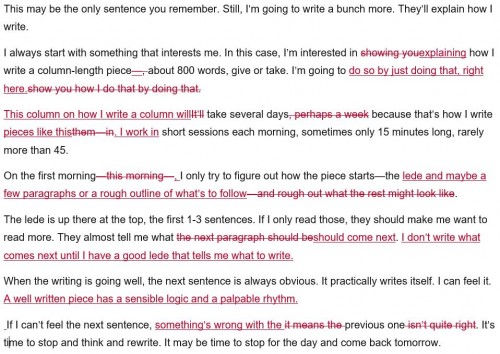This may be the only sentence you remember. Still, I’m going to write a bunch more. They’ll explain how I write.
I always start with something that interests me. In this case, I’m interested in explaining how I write a column-length piece—about 800 words, give or take. I’m going to do so by just doing that, right here.
This column on how I write a column will take several days because that’s how I write pieces like this. I work in short sessions each morning, sometimes only 15 minutes long, rarely more than 45.
On the first morning, I only try to figure out how the piece starts—the lede and maybe a few paragraphs or a rough outline of what’s to follow.
The lede is up there at the top, the first 1-3 sentences. If I only read those, they should make me want to read more. They almost tell me what should come next. I don’t write what comes next until I have a good lede that tells me what to write.
When the writing is going well, the next sentence is always obvious. It practically writes itself. I can feel it. A well written piece has a sensible logic and a palpable rhythm. If I can’t feel the next sentence, something’s wrong with the previous one. It’s time to stop and think and rewrite. It may be time to stop for the day and come back tomorrow.
When I come back to my draft, I always read it from the top and edit as I go. Today, I did that to the preceding paragraphs, which I had originally drafted yesterday.

Each paragraph is a thought, and I want them to flow in a logical order. I usually make the logic plain by including in the first sentence of each paragraph something that links to the thought conveyed in the prior one. One word in common word is often enough. For example, the third paragraph of this piece mentions I write in short sessions each morning. The first sentence of the fourth paragraph begins with “On the first morning …”
Some of my favorite writers on health care, such as Atul Gawande and Lisa Rosenbaum, start some paragraphs abruptly, bringing in a new thought without initially explaining its relevance. This adds intrigue. So long relevance is clarified within a few sentences, it works.
However I write my paragraphs, I’ll often reorder them later. But I have to write them first!
Let’s get one thought straight: the entire piece should have one idea. What is it? The lede tells you. And, usually by the time I’m about midway through a piece, I want to make sure that idea comes through in the concluding paragraph too. So, I write it before I’ve written the entire body of the piece, as I have below.
Possible sketch of the rest:
- Sentences: short and long
- Words: explain the selection of “sensible logic and a palpable rhythm”. It was originally, “clear logic and precise rhythm.”
- From paragraphs, ordered as you like, to words, well chosen, the draft is written. Now what? Find a reviewer/editor
I’m frequently asked how I write. This series of posts answers that question by illustrating the process that culminated in a column-length piece on that subject. Will anyone learn anything from it? I’m skeptical. Most writing is forgotten. That itself is an important lesson about writing: Readers may only remember your first sentence … or your last.

